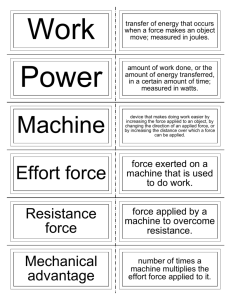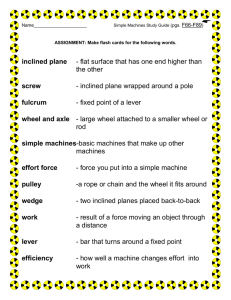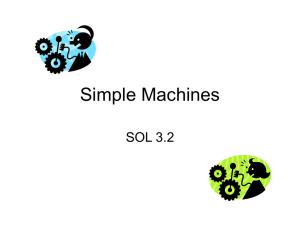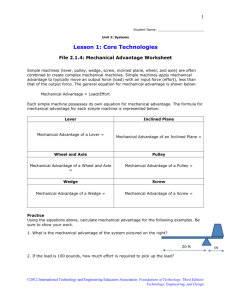Simple Machines - Temple University Sites
advertisement
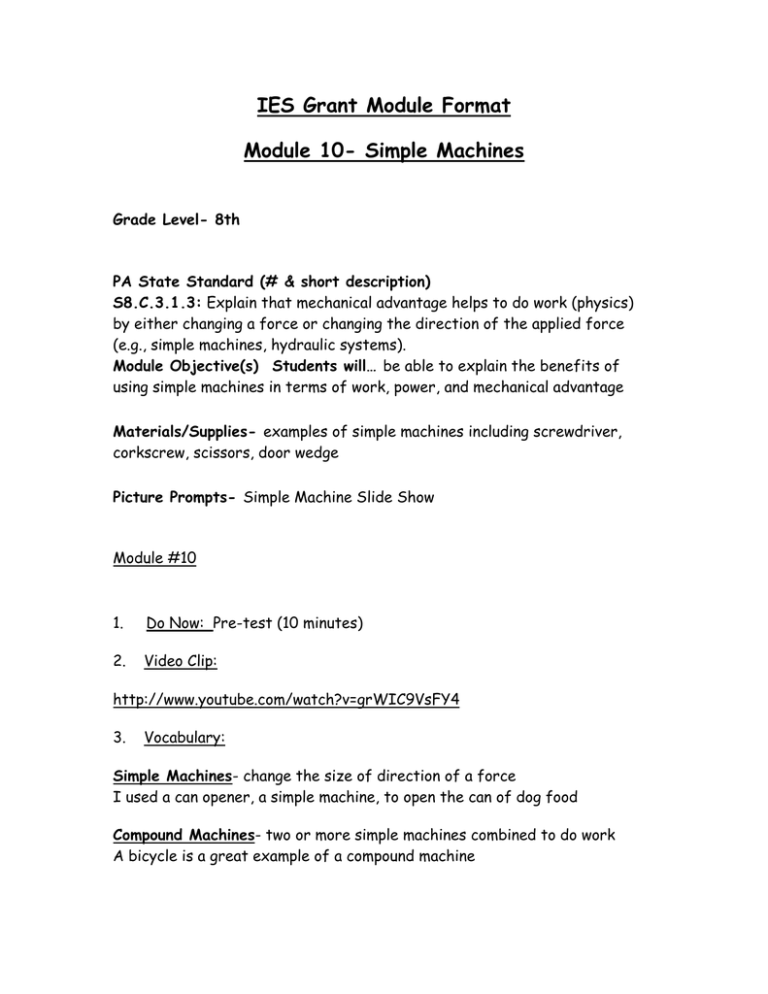
IES Grant Module Format Module 10- Simple Machines Grade Level- 8th PA State Standard (# & short description) S8.C.3.1.3: Explain that mechanical advantage helps to do work (physics) by either changing a force or changing the direction of the applied force (e.g., simple machines, hydraulic systems). Module Objective(s) Students will… be able to explain the benefits of using simple machines in terms of work, power, and mechanical advantage Materials/Supplies- examples of simple machines including screwdriver, corkscrew, scissors, door wedge Picture Prompts- Simple Machine Slide Show Module #10 1. Do Now: Pre-test (10 minutes) 2. Video Clip: http://www.youtube.com/watch?v=grWIC9VsFY4 3. Vocabulary: Simple Machines- change the size of direction of a force I used a can opener, a simple machine, to open the can of dog food Compound Machines- two or more simple machines combined to do work A bicycle is a great example of a compound machine Mechanical Advantage- the force output divided by the force input Susan used mechanical advantage to determine which machine was better Efficiency- the energy output compared to the energy input The efficiency of the new appliances is much greater than the old ones Work- is equal to the amount of force multiplied by the distance an object is moved (W = F X d, unit is the Joule) Billy did a lot of work moving all the desks to the back of the room Power- is the rate at which we do work. Power is equal to Work divided by Time (P = W/t, unit is the Watt) Dawn has a lot of power as she was able to move the desk much quicker than Billy Lever- rigid support that pivots on a point Angel used the lever to pry open the door Inclined Plane- slanted surfaces that help you do work The moving company used an incline plane to move the furniture onto the truck Pulley- wheel and axle with a rope The garage uses a pulley system to lift the engine out of the car Wedge- inclined plane usually used for cutting My dad used the wedge to help split the fire wood Screw- inclined planes wrapped around a cylinder The screws were used to hold the two pieces of wood together Wheel and Axle- made of two parts that turn together The wheel and axle used on the old horse and buggies is still used on cars today 4. Lecture Part 1: What do machines do? Machines help us do work. There are two types of machines: simple machines and compounds machines. Compound machines are made up of two or more simple machines. The machines we will concentrate on more in science class are called simple machines. You need to know that Simple Machines will change the size or direction of a force in one motion. Its good to know that Compound Machines are a system of two or more simple machines. Please know that machines do four things; 1. Help us do work more easily. (Machines do not save work from being done.) 2. A machine can make the force you put into a machine greater. (ex. Pliers) 3. A machine can change the direction of the force you put in. ( ex. A Car jack) 4. A machine can increase the speed of the force. (ex. Bicycle) Before we move on, there are three important words associated with simple machines; Efficiency, Work, and Power When we deal with machines, we always want them to be very efficient. Write this down, the energy output compared to the energy input is called efficiency. So what is work? Take note that in order for work to be done two conditions must be met. 1. An object must move. 2. A force must act on the object in the same direction as the object's motion. When doing work a force must move an object some distance. The force and distance the object moves must also be in the same direction. Therefore if the object does not move no work is being done. A girl holding a book above a table is not doing any work. She may be exerting a force but NO work is being done. If you are carrying an object the direction of motion and the direction of the force are different. Therefore, no work is being done. Work is measured in units called Joules. In order to calculate work you need to have the measurement for Force and Distance. Force is measured in Newtons. Distance in measured in units called Meters. You should know that the formula for work is W=Fxd For example, If you move a desk with a force of 5 N a distance of 10 m, we can solve with Work = 5 N X 10 m = 50 Joules of work. What is power? This is on your test, Power is the rate at which we complete work. How much work we get done in a certain amount of time? For example: Jack and Jill both have to mow the lawn. Jack completes his 1/2 acre lawn in 1 hour while Jill completes her 1/2 acre lawn in 1/2 hour. Who is more powerful? Since Jill completed her work in less time she was more powerful. The unit we use to measure power is the Watt. In order to measure power we need the measurements for Work and Time. Work is measured in units called Joules. Time is measured in units called seconds. You need to know that the formula is for power is: P= W/T. The units for Power are Watss (W). Lets solve the lawn mowing problem to check our answer. Jack .5/1 = .5 W Jill .5/.5 = 1 W Jill is more powerful. Both work and power are related to machines. Machines help us to do work and can help us to increase power. The more efficient a machine, the better. Now lets get back to simple machines. Simple machines: Lets take a look at the six simple machines. The first we will cover is called a lever: Please know that a lever is a rigid support that pivots on a point. The seesaw is a great example. Levers come in three classes. Depending on what is in the middle depends upon what class of lever it is. If the fulcrum (pivot point) is in the middle then the lever is a first class. If the resistance (load) is in the middle then the lever is a second class. If the effort (force you put in) is in the middle then the lever is a third class. Inclined planes: You also need to know about inclined planes. Inclined planes are slanted surfaces that help you do work. Some examples are stairs and ramps. Inclined planes along with the other simple machines provide us with an advantage. Pulley: Please know that A pulley is a very common simple machine. Did you ever open or close the blinds in your house? If you did you used a pulley. A pulley has two parts: 1. a wheel that turns on an axle. 2. a rope that runs over the wheel. Some examples of pulleys include: clotheslines, blinds, flagpoles, zip lines and sailboats. When calculating the mechanical advantage of a pulley you would count the number of supporting ropes except the effort rope if it goes down. Wedge: Write this down, A wedge is an inclined plane usually used for cutting. An axe, scissors or knife are two common examples. The longer the wedge the greater the mechanical advantage. Screw: Write this down also, The screw is an inclined plane wrapped around a cylinder. The closer together the teeth the greater the mechanical advantage. Gears and Wheels: You have to know that Gears are wheels with teeth. Larger wheels usually turn smaller ones this will increase the speed of the smaller gears. A wheel and axle is made of two parts that turn together. A screw driver is a great example. The bulb handle is connected to the long axle that turns the screw. Please note, we use simple machines to make tasks easier. And Remember a simple machine can multiply input forces OR multiply input distances (but never both at the same time). Ok. I mentioned Mechanical Advantage for each simple machine. You need to know that Mechanical Advantage will tell you the advantage you are gaining from using a machine. The greater the number, the greater the advantage. Simple machines make life easier. This ends our module on Simple Machines. 5. Activity: Simple Machine Pulley Lab 6. Review Notes: Address Note-taking students, “Go to the last page of your notes and write five lecture points, you may refer to your notes”, Address all other students, “Fill in any gaps in your notes”. 7. Post Test: 8. Homework/Follow-up Simple Machines Reading Guide


